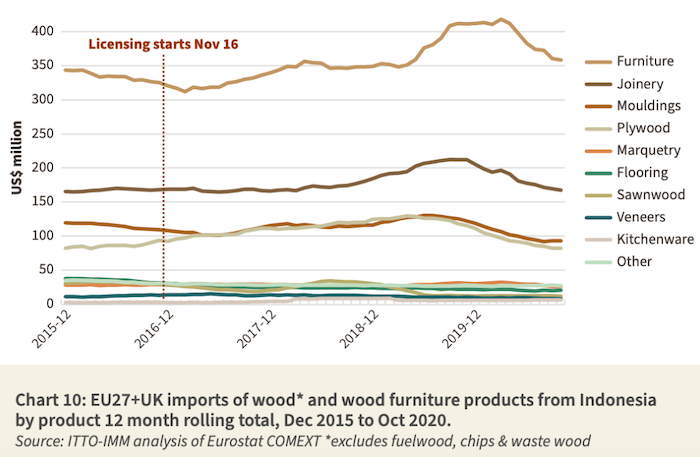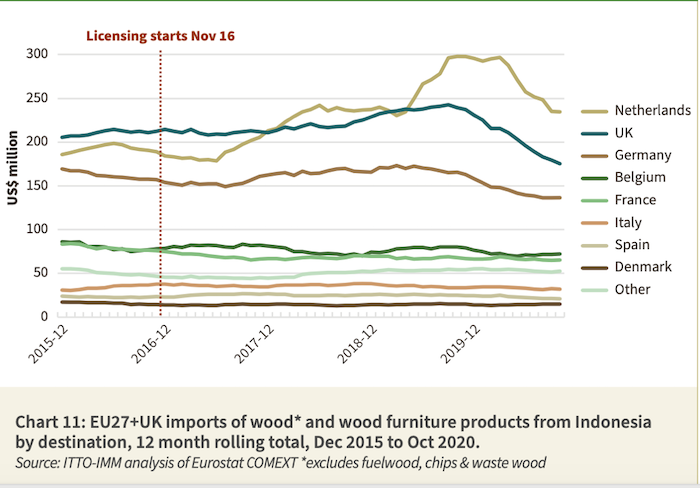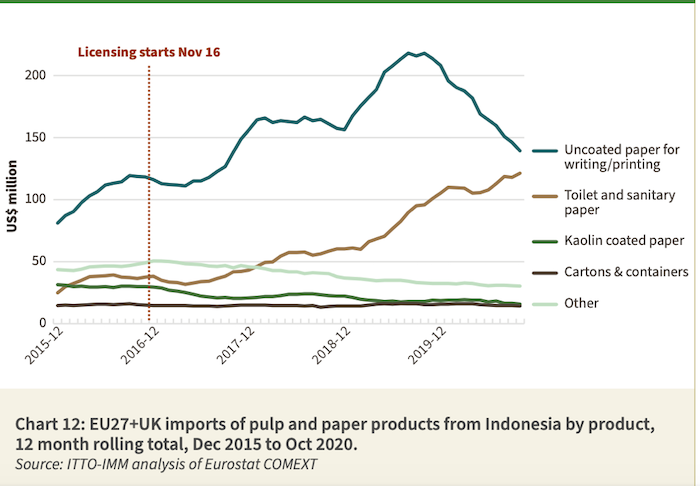Indonesia’s exports of forest and wood products to all destinations held up better than expected in 2020. According to a statement in January 2021 by Bambang Hendroyono, the Secretary General in the Indonesian Ministry of Environment and Forestry, Indonesia’s 2020 export target for forest and wood products was projected to be exceeded despite the impact of the corona pandemic on production and trade. Early in 2020 the export target was lowered from US$10 billion to US$7 billion to take account of the anticipated disruption of business. However, export earnings in 2020 were expected to exceed US$11 billion, even more than the original target and only 5% below that of 2019. The Secretary General emphasised that Indonesian Government incentives and relaxation of regulations helped achieve this success.
Indonesian forest products export data (available at www.stats.flegtimm.eu) shows that in the first 10 months of 2020 Indonesia’s worldwide exports of forest products were already close to US$10 billion and only 3% down on the same period in 2019. HS44 (wood) were down 3% to US$3.10 billion, HS47 (pulp) fell 10% to US$2.11 billion, and HS47 (paper) fell 4% to US$3.54 billion. Indonesia’s exports of wood furniture were actually 10% higher at US$1.23 billion. The gain in Indonesia’s exports last year were mainly made in China and the United States.
In contrast, the pandemic had a severe effect on EU27+UK imports of forest products from Indonesia in 2020, effectively wiping out the significant gains made during the previous two years. In the first 10 months of 2020 compared to the same period in 2019, EU27+UK imports of all forest products from Indonesia fell 22% to US$933 million, with HS44 (wood) products down 24% to US$388 million, wood furniture down 20% to US$290 million and paper down 23% to US$255 million.

For wood furniture, a big decline in EU27+UK imports of Indonesian occurred in April and May, exactly coinciding with the first lockdown period. The value lost during this period was also almost exactly equivalent to the gains made in 2019 so that trade in the third quarter was back to 2018 levels (Chart 10).
EU27+UK imports of Indonesian joinery, mouldings/decking, and plywood were already falling in the six months prior to the pandemic and the downward trend continued during the lockdown in the second quarter of 2020. However, there was slowing in the pace of decline in the third quarter. EU27+UK imports of other wood product groups from Indonesia, including marquetry/ornaments, flooring, S4S sawnwood and veneers, while still low in 2020, did not experience any significant downturn during the year.
The 2019 upturn and 2020 decline in Indonesian wood furniture imports into the EU27+UK was mainly driven by trade with the Netherlands. The Netherlands market remained resilient throughout 2019 and into the first quarter of 2020 but slowed dramatically in the second and third quarter last year.
Imports of Indonesian wood and wood furniture into the UK, Germany, and Belgium were already weakening in the last quarter of 2019 and first quarter of 2020. In the case of the UK, the sharp downturn continued throughout the second and third quarter of 2020. However, the pace of decline in imports into Germany and Belgium slowed in the second quarter and trade stabilised in the third quarter. Imports of Indonesian wood products into other major EU markets, including France, Italy, Spain, and Denmark remained reasonably stable in 2019 and 2020 (Chart 11).

Recent trends in EU27+UK paper imports from Indonesia appear less influenced by the COVID pandemic than other market factors. Imports of uncoated paper products for writing/printing were rising strongly between the start of 2017 and the middle of 2019, but then began to decline sharply in the second half of 2019 well before the pandemic impacted on the market, a decline which continued last year. Throughout this whole period imports of toilet and sanitary papers from Indonesia continued to rise, with a only a slight and brief slowdown in the second quarter last year. EU27+UK imports of other paper products from Indonesia were flat or declining between 2017 and 2019 and these trends continued last year (Chart 12).

EU27+UK imports of uncoated paper products for writing/printing are destined mainly for the UK, Belgium, Italy and Slovenia. Imports into all these markets peaked in mid-2019 and were declining even before the pandemic. However, the UK market was particularly volatile. The rising quantity of Indonesian toilet and sanitary paper imported into the EU27+UK between 2017 and 2019 was destined mainly for the UK and Greece. In 2020 imports into the UK declined sharply but imports into Greece continued to rise and Poland also emerged as a more important market.
